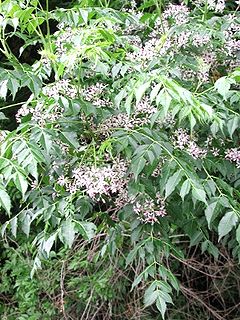
Meliaceae, the mahogany family, is a flowering plant family of mostly trees and shrubs in the order Sapindales.

The white perch is not a true perch but is a fish of the temperate bass family, Moronidae, notable as a food and game fish in eastern North America. In some places it is referred to as "Silver Bass".

The dwarf little fruit bat is a species of leaf-nosed bat from South America.

Elachistocleis ovalis, commonly known as the common oval frog, is a dubious species of frog in the family Microhylidae. The type species of Elachistocleis, it was described without a holotype or type locality, and due to this it is not known exactly to which population the name Elachistocleis ovalis applies, making it a nomen nudum. The Amphibian Species of the World restricts this species to Panama, Colombia, Trinidad and Tobago, and Bolivia. Frog species from Brazil have been allocated to other species. A 2021 study found all populations assigned to E. ovalis across South America to represent several different undescribed species, likely indicating that the name E. ovalis is invalid without knowledge of the original population.
Elachistocleis skotogaster is a species of frog in the family Microhylidae. It is known with certainty only from the Salta Province in northern Argentina. However, the type locality and some later observations are near the border to Bolivia, and it is possible that some frogs from Bolivia currently attributed to Elachistocleis ovalis belong to this species.

The striped stingaree is a common but little-known species of stingray in the family Urolophidae, endemic to shallow, inshore waters off southwestern Australia. Reaching 61 cm (24 in) long, this species is characterized by an oval, grayish to brownish disc with darker mask-like markings around the eyes and paired blotches at the center of the disc that are extended posteriorly into horizontal lines. Its nostrils have enlarged lobes on the outer margins and a skirt-shaped curtain of skin with a deeply fringed trailing margin in between. Its tail terminates in a relatively large leaf-shaped caudal fin, and bears a small dorsal fin just before the stinging spine. The rounded, flexible disc of the striped stingaree enable it to maneuver through the rocks, reefs, and seagrass that comprise its favored habitats. The International Union for Conservation of Nature (IUCN) has listed this species under Least Concern; it is seldom caught by fisheries due to its habitat preferences.
Ilex ovalis is a species of flowing plant in the holly family Aquifoliaceae. It is native to Ecuador and Peru.
Lithocarpus ovalis is a species of plant in the family Fagaceae. It is endemic to the Philippines.
Melicope ovalis, the wild pelea or Hana melicope, is a species of tree in the family Rutaceae. It is endemic to Maui, of the Hawaiian Islands.
Oncoba ovalis is a species of plant in the Salicaceae family. It is found in Cameroon and Nigeria. Its natural habitat is subtropical or tropical dry forests. It is threatened by habitat loss.
Ruagea membranacea is a species of plant in the family Meliaceae. It is endemic to Ecuador.

Ruagea is a genus of plants in the family Meliaceae. It contains the following species :
Ruagea microphylla is a species of plant in the family Meliaceae. It is endemic to Ecuador. It has been listed as an endangered species by the International Union for Conservation of Nature (IUCN)

Amelanchier ovalis, commonly known as snowy mespilus is a serviceberry shrub. Its pome fruits are edible and can be eaten raw or cooked. The species is native to central and southern Europe, as well as North Africa and the Middle East.
Abrostola ovalis, the oval abrostola, is a moth of the family Noctuidae. The species was first described by Achille Guenée in 1852. It is found in north-eastern North America from southern Quebec and Maine south to North Carolina and west to Wisconsin.
Aegeofusinus rolani is a species of sea snail, a marine gastropod mollusk in the family Fasciolariidae, the spindle snails, the tulip snails and their allies.
Radix luteola is a species of freshwater snail, an aquatic gastropod mollusc in the family Lymnaeidae.
Concavodonta is an extinct genus of early bivalve in the extinct family Praenuculidae. The genus is one of three genera in the subfamily Concavodontinae. Concavodonta is known solely from late Ordovician, Caradoc epoch, fossils found in Europe and South America. The genus currently contains three accepted species, Concavodonta imbricata, Concavodonta ovalis and the type species Concavodonta ponderata.

Halodule uninervis is a species of seagrass in the family Cymodoceaceae. It is native to the western Pacific and Indian Oceans. Common names include narrowleaf seagrass in English and a'shab bahriya in Arabic.
Holozoster ovalis is a species of harvestmen endemic to Mahe Island of Seychelles.








